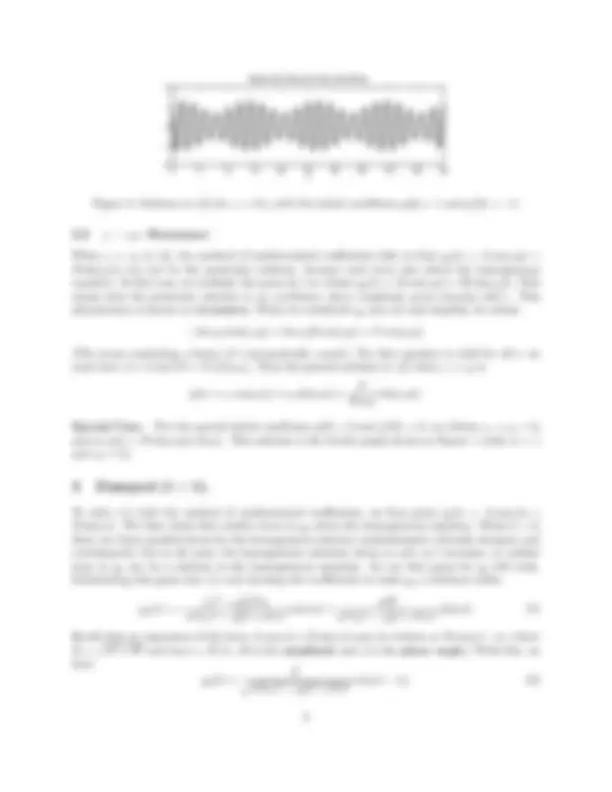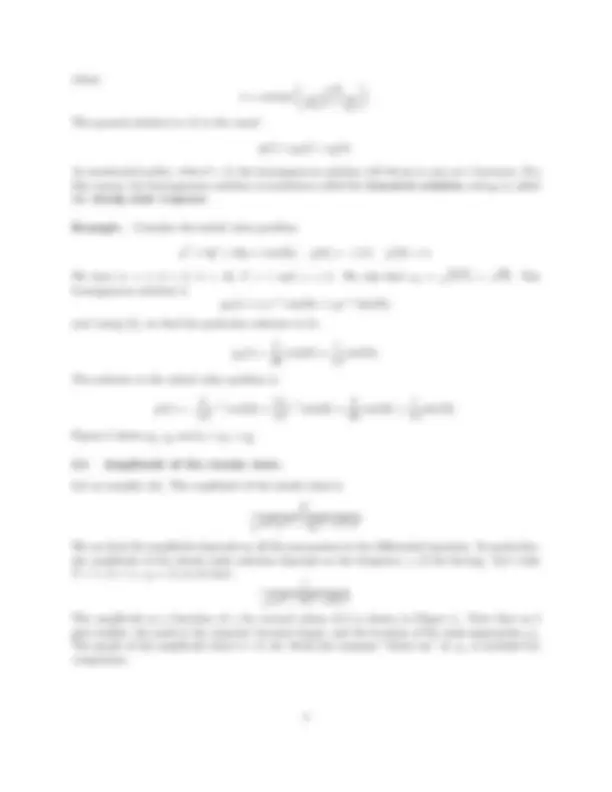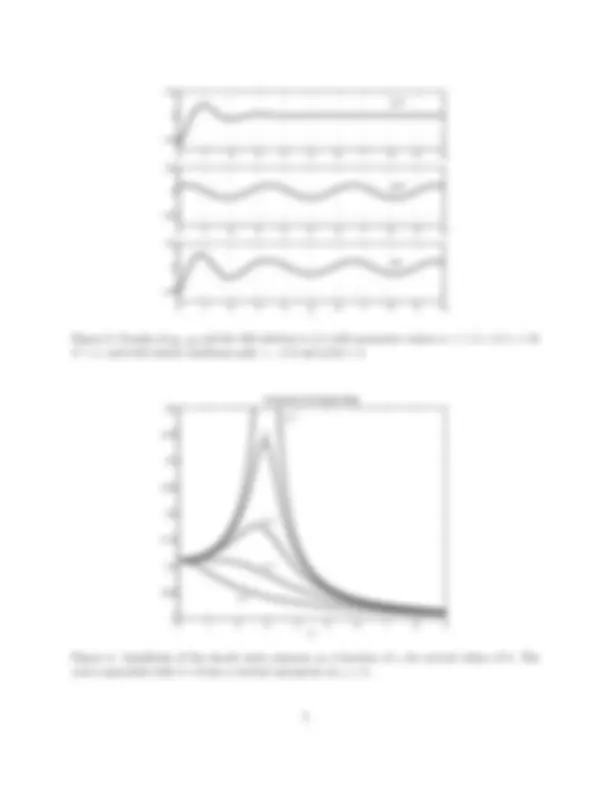





Study with the several resources on Docsity

Earn points by helping other students or get them with a premium plan


Prepare for your exams
Study with the several resources on Docsity

Earn points to download
Earn points by helping other students or get them with a premium plan
Community
Ask the community for help and clear up your study doubts
Discover the best universities in your country according to Docsity users
Free resources
Download our free guides on studying techniques, anxiety management strategies, and thesis advice from Docsity tutors
Material Type: Notes; Class: Differential Equations; Subject: Mathematics; University: Colgate University; Term: Unknown 1989;
Typology: Study notes
1 / 6

This page cannot be seen from the preview
Don't miss anything!




By periodically forced harmonic oscillator, we mean the linear second order nonhomogeneous dif- ferential equation my′′^ + by′^ + ky = F cos(ωt) (1)
where m > 0, b ≥ 0, and k > 0. We can solve this problem completely; the goal of these notes is to study the behavior of the solutions, and to point out some special cases. The parameter b is the damping coefficient (also known as the coefficient of friction). We consider the cases b = 0 (undamped) and b > 0 (damped) separately.
When b = 0, we have the equation
my′′^ + ky = F cos(ωt). (2)
For convenience, define
ω 0 =
k m
This is the “natural frequency” of the undamped, unforced harmonic oscillator. To solve (2), we must consider two cases: ω 6 = ω 0 and ω = ω 0.
By using the method of undetermined coefficients, we find the solution of (2) to be
y(t) = c 1 cos(ω 0 t) + c 2 sin(ω 0 t) +
m(ω^2 − ω^20 )
cos(ωt), (3)
where, as usual, c 1 and c 2 are arbitrary constants. Note that the amplitude of yp becomes larger as ω approaches ω 0. This suggests that something other than a purely sinusoidal function may result when ω = ω 0.
−1 0 5 10 15 20 25 30 35 40 45 50
0
(^1) ω=3.
Beats and Resonance
−2 0 5 10 15 20 25 30 35 40 45 50
0
2 ω=3.
−5 0 5 10 15 20 25 30 35 40 45 50
0
5 ω=3.
−10 0 5 10 15 20 25 30 35 40 45 50
0
10 ω=3 (resonance)
t
Figure 1: Solutions to (2) for several values of ω. The initial conditions are y(0) = 0 and y′(0) = 0. The solid curves are the actual solutions, while the dashed lines show the envelope (or modulation) of the amplitude.
Beats. Let us consider the initial conditions y(0) = 0 and y′(0) = 0. We must have c 1 = −F/(m(ω^2 − ω^20 )) and c 2 = 0, which gives
y(t) =
m(ω^2 − ω^20 )
(cos(ωt) − cos(ω 0 t)).
in (3). By using some trigonometric identities, we may rewrite this as
y(t) =
m(ω^20 − ω^2 )
sin
(ω 0 + ω)t 2
sin
(ω 0 − ω)t 2
Now, if ω ≈ ω 0 , we can think of this expression as the product of
sin
(ω 0 + ω)t 2
and
m(ω 02 − ω^2 )
sin
(ω 0 − ω)t 2
Since ω ≈ ω 0 , |ω 0 − ω| is small, the first expression has a much higher frequency than the second. We see that the solution given in (4) is a “high” frequency oscillation, with an amplitude that is modulated by a low frequency oscillation. In Figure 1, we consider an example where F = 1, m = 1, and ω 0 = 3. In the first three graphs, the solid lines are y(t) given by (4), and the dashed lines show the envelope or modulation of the amplitude of the solution. Note that the vertical scale is different in each graph: the amplitude increases as ω approaches ω 0. Remember that the solutions in Figure 1 are for the special initial conditions y(0) = 0 and y′(0) = 0. Beats occur with other initial conditions, but the function that modulates the amplitude of the high frequency oscillation will not be a simple sine function. Figure 2 shows a solution to (2) with ω 0 = 3.5, but with y(0) = 1 and y′(0) = −2.
where
φ = arctan
−ωb m(ω^2 − ω 02 )
The general solution to (1) is the usual
y(t) = yh(t) + yp(t).
As mentioned earlier, when b > 0, the homogeneous solution will decay to zero as t increases. For this reason, the homogeneous solution is sometimes called the transient solution, and yp is called the steady state response.
Example. Consider the initial value problem
y′′^ + 2y′^ + 10y = cos(2t), y(0) = − 1 / 2 , y′(0) = 4.
We have m = 1, b = 2, k = 10, F = 1 and ω = 2. We also find ω 0 =
k/m =
and, using (5), we find the particular solution to be
yp(t) =
cos(2t) +
sin(2t).
The solution to the initial value problem is
y(t) = −
e−t^ cos(3t) +
e−t^ sin(3t) +
cos(2t) +
sin(2t).
Figure 3 shows yh, yp and y = yh + yp.
Let us consider (6). The amplitude of the steady state is
F √ m^2 (ω^2 − ω^20 )^2 + b^2 ω^2
We see that the amplitude depends on all the parameters in the differential equation. In particular, the amplitude of the steady state solution depends on the frequency ω of the forcing. Let’s take F = 1, m = 1, ω 0 = 3, so we have 1 √ (ω^2 − 9)^2 + b^2 ω^2
The amplitude as a function of ω for several values of b is shown in Figure 4. Note that as b gets smaller, the peak in the response becomes larger, and the location of the peak approaches ω 0. The graph of the amplitude when b = 0, for which the response “blows up” at ω 0 , is included for comparison.
0 1 2 3 4 5 6 7 8 9 10
−0.
0
yh(t)
0 1 2 3 4 5 6 7 8 9 10
−0.
0
yp(t)
0 1 2 3 4 5 6 7 8 9 10
−0.
0
t
y(t)
Figure 3: Graphs of yh, yp and the full solution to (1) with parameter values m = 1, b = 2, k = 10, F = 1, and with initial conditions y(0) = − 1 /2 and y′(0) = 4.
(^00 1 2 3 4 5 6 7 8 )
ω
b= b=
b=
b=
b=
Amplitude of the Steady State
Figure 4: Amplitude of the steady state response as a function of ω for several values of b. The curve associated with b = 0 has a vertical asymptote at ω = 3.